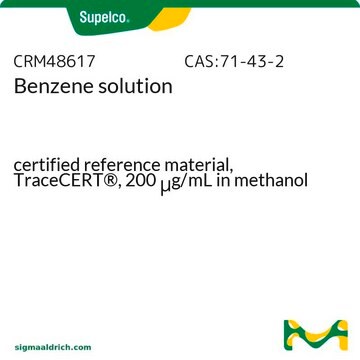32212
Benzene
puriss. p.a., reag. Ph. Eur., ≥99.7%
About This Item
Polecane produkty
agency
ISO
USP/NF
reag. Ph. Eur.
gęstość pary
2.77 (vs air)
ciśnienie pary
166 mmHg ( 37.7 °C)
74.6 mmHg ( 20 °C)
klasa czystości
puriss. p.a.
Próba
≥99.7%
Postać
liquid
temp. samozapłonu
1043 °F
granice wybuchowości
8 %
zanieczyszczenia
≤0.0002% free alkali (as NH3)
≤0.0004% free acid (as HCl)
≤0.001% non-volatile matter
≤0.03% water (Karl Fischer)
≤1 ppm thiophene
kolor
APHA: ≤10
współczynnik refrakcji
n20/D 1.5000-1.5020
n20/D 1.501 (lit.)
tw
80 °C (lit.)
mp
5.5 °C (lit.)
temp. przejścia
solidification point ≥5.2 °C
gęstość
0.874 g/mL at 25 °C (lit.)
ślady kationów
Al: ≤0.5 mg/kg
B: ≤0.02 mg/kg
Ba: ≤0.1 mg/kg
Ca: ≤0.5 mg/kg
Cd: ≤0.05 mg/kg
Co: ≤0.02 mg/kg
Cr: ≤0.02 mg/kg
Cu: ≤0.01 mg/kg
Fe: ≤0.1 mg/kg
Mg: ≤0.1 mg/kg
Mn: ≤0.02 mg/kg
Ni: ≤0.02 mg/kg
Pb: ≤0.01 mg/kg
Sn: ≤0.1 mg/kg
Zn: ≤0.01 mg/kg
ciąg SMILES
c1ccccc1
InChI
1S/C6H6/c1-2-4-6-5-3-1/h1-6H
Klucz InChI
UHOVQNZJYSORNB-UHFFFAOYSA-N
Szukasz podobnych produktów? Odwiedź Przewodnik dotyczący porównywania produktów
Powiązane kategorie
Opis ogólny
Zastosowanie
Inne uwagi
Hasło ostrzegawcze
Danger
Zwroty wskazujące rodzaj zagrożenia
Zwroty wskazujące środki ostrożności
Klasyfikacja zagrożeń
Aquatic Chronic 3 - Asp. Tox. 1 - Carc. 1A - Eye Irrit. 2 - Flam. Liq. 2 - Muta. 1B - Skin Irrit. 2 - STOT RE 1
Organy docelowe
Blood
Kod klasy składowania
3 - Flammable liquids
Klasa zagrożenia wodnego (WGK)
WGK 3
Temperatura zapłonu (°F)
12.2 °F
Temperatura zapłonu (°C)
-11 °C
Certyfikaty analizy (CoA)
Poszukaj Certyfikaty analizy (CoA), wpisując numer partii/serii produktów. Numery serii i partii można znaleźć na etykiecie produktu po słowach „seria” lub „partia”.
Masz już ten produkt?
Dokumenty związane z niedawno zakupionymi produktami zostały zamieszczone w Bibliotece dokumentów.
Nasz zespół naukowców ma doświadczenie we wszystkich obszarach badań, w tym w naukach przyrodniczych, materiałoznawstwie, syntezie chemicznej, chromatografii, analityce i wielu innych dziedzinach.
Skontaktuj się z zespołem ds. pomocy technicznej





